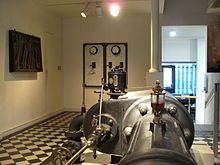lubrication

Lubrication is the reduction of friction and wear between two machine elements ("friction partners") that move relative to each other. This is done through the use of a suitable lubricant and lubrication process in tribology .
Lubrication can be classified similar to friction:
- Boundary layer lubrication - similar to solid-state or boundary friction
- Partial lubrication - similar to mixed friction
- Full lubrication - similar to fluid friction
Boundary layer lubrication
The lubricant penetrates the solid body and a reaction layer forms. The load is borne by the roughness peaks of the friction partners.
Partial lubrication
The load is partly absorbed by the lubricating film and partly by the touching roughness peaks.
Full lubrication
The load is completely absorbed by the lubricant. The contact surfaces are separated. Full lubrication can be further divided into:
- hydrostatic or aerostatic lubrication
- hydrodynamic lubrication
- elastohydrodynamic lubrication
Hydrostatic lubrication (for air : aerostatic lubrication)
The contact surfaces are separated by pumping the lubricant into the lubrication gap. This form of lubrication is technically very complex and structurally very demanding. The result is an almost frictionless shift, since the hydrostatic lubrication immediately results in fluid friction, but these processes, due to the demanding production, result in higher costs.
Hydrodynamic lubrication
The lubricant is fed into the narrowing lubrication gap (also known as the converging lubrication gap or lubricating wedge) through the relative movement of the contact surfaces to one another. The pressure in the lubricant is so high that the contact surfaces are lifted from one another. In reality, however, mixed friction and / or stick-slip effects ( stick-slip ) often occur . There is a low sliding speed.
Elastohydrodynamic lubrication
This form of lubrication occurs in contact with highly loaded moving rollers, e.g. B. with gears and roller bearings . In addition to the basic hydrodynamic equations, the theory of elastohydrodynamics (EHD theory) also takes into account the elastic deformation of the bodies in contact as a result of the hydrodynamic pressure. Touching the interfaces is not taken into account here; pure fluid friction thus occurs. Characteristic for EHD lubrication is a narrowing of the lubrication gap at the end of the contact zone, which is in connection with a pressure peak at this point. The height of the pressure peak is usually less than the maximum hydrodynamic pressure.
The EHD theory provides the basis for calculating the influence of lubrication on gear damage such as pits, seizure or micro-pitting .
Super lubrication
For superlubricity , which was only proven in 2004 between graphene surfaces, in which the friction can almost completely disappear, the technical application is still pending.
See also
literature
- Georg Vogelpohl: Reliable plain bearings. Calculation method for construction and operation. Springer-Verlag, Berlin et al. 1958, 315 pp.
- Otto R. Lang: History of the plain bearing. Daimler-Benz AG, Stuttgart, 1982.
- Valentin L. Popov: Contact Mechanics and Friction. A text and application book from nanotribology to numerical simulation . Springer-Verlag, Berlin et al. 2009, 328 pages, ISBN 978-3-540-88836-9 .
Individual evidence
- ↑ Polymer brushes in aqueous solvent mixtures impact of polymer conformation on tribological properties (accessed on August 9, 2018)
- ↑ Lubricants for motor vehicles (accessed on August 9, 2018)
- ^ Waldemar Steinhilper, Rudolf Röper: Maschinen- und Konstruktionselemente 3. Springer Verlag, Berlin / Heidelberg 1994, ISBN 978-3-540-57429-3 , pp. 260-261.
- ↑ Roland Wegmann: Extension of the hydrodynamic lubrication theory by including the negative pressure area in the calculation of unsteady loaded plain bearings. Dissertation at the Wilhelm Pieck University, Rostock 2009. Online (accessed on August 9, 2018)
- ^ Forschungskuratorium Maschinenbau eV (Ed.): Elastohydrodynamische Schmierung. Theoretical and experimental investigations to extend the EHD theory to practical and unsteady conditions. Online (accessed August 9, 2018)
Web links
- Lubrication of rolling bearings (accessed August 9, 2018)
- Lubrication (accessed August 9, 2018)
- Chain lubrication (accessed August 9, 2018)
- On the trail of full lubrication (accessed on August 9, 2018)